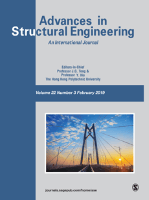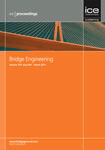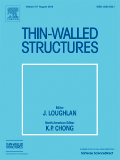
ADVANCES IN STRUCTURAL ENGINEERING
Scope & Guideline
Elevating Knowledge in Civil and Structural Engineering
Introduction
Aims and Scopes
- Seismic Engineering:
Research on seismic performance, design methodologies, and retrofitting techniques for structures subjected to seismic loads. - Innovative Materials:
Exploration of new materials, such as fiber-reinforced polymers and ultra-high-performance concrete, and their applications in structural systems. - Structural Health Monitoring:
Development and application of advanced monitoring techniques and sensors for assessing the condition and performance of structures. - Computational Modeling and Simulation:
Utilization of numerical methods and simulations for predicting structural behavior under various loading conditions. - Sustainable and Resilient Infrastructure:
Focus on sustainable design practices and resilience strategies for infrastructure in the face of environmental challenges. - Machine Learning Applications:
Incorporation of machine learning algorithms for predictive modeling, damage detection, and optimization in structural engineering.
Trending and Emerging
- Digital Twin Technology:
An increasing focus on digital twin technology for real-time monitoring and predictive maintenance of structures, enabling smarter infrastructure management. - Advanced Computational Techniques:
Growing interest in advanced computational methods, including machine learning and artificial intelligence, for structural analysis and design optimization. - Sustainability and Green Engineering:
Heightened emphasis on sustainability practices, including the use of recycled materials and energy-efficient designs in structural engineering. - Resilience Engineering:
Emerging research on enhancing the resilience of structures against natural disasters, climate change, and other environmental challenges. - Smart Materials and Systems:
Increased exploration of smart materials and systems that can adapt to changing conditions and improve structural performance.
Declining or Waning
- Traditional Materials and Methods:
Research focusing primarily on conventional materials and methods of structural design and analysis has decreased as newer materials and advanced methodologies gain traction. - Basic Structural Analysis Techniques:
The prevalence of basic analytical methods is declining in favor of more sophisticated computational techniques and data-driven approaches. - Static Load Analysis:
There is a noticeable reduction in studies centered around static load analysis, as dynamic loading conditions and performance-based design become more prominent. - Conventional Seismic Design Codes:
Research centered solely on traditional seismic design codes without the integration of modern technologies and methodologies is becoming less common.
Similar Journals

Proceedings of the Institution of Civil Engineers-Bridge Engineering
Driving Innovations for Tomorrow's InfrastructureProceedings of the Institution of Civil Engineers - Bridge Engineering, published by Emerald Group Publishing Ltd, is a pivotal academic journal that delves into the essential and dynamic field of bridge engineering and design. With an ISSN of 1478-4637 and an E-ISSN of 1751-7664, this journal serves as a vital resource for researchers, professionals, and students seeking to expand their knowledge and stay updated with the latest advancements and innovations in civil and structural engineering. The journal has demonstrated its relevance in the academic community with a current Scopus ranking of 101/223 in Engineering - Building and Construction and 193/379 in Engineering - Civil and Structural Engineering, both placing it in the Q3 quartile category. Despite its traditional publishing format, the journal remains a key platform for high-quality research from 2004 to 2024, especially for those interested in the intricacies of bridge development, maintenance, and sustainability. Ultimately, Proceedings of the Institution of Civil Engineers - Bridge Engineering aims to bridge the gap between theoretical knowledge and practical application, driving innovation and excellence in the realm of civil engineering.

Bulletin of Earthquake Engineering
Innovating solutions for earthquake safety.The Bulletin of Earthquake Engineering is a premier journal published by Springer, dedicated to the field of earthquake engineering and its related disciplines. Established in 2003, this esteemed journal has evolved into a critical platform for disseminating cutting-edge research in Building and Construction, Civil and Structural Engineering, Geophysics, and Geotechnical Engineering and Engineering Geology, earning a distinguished position in the Q1 quartile across these categories. With an impressive ranking in Scopus, notably a rank of #8 in Earth and Planetary Sciences for Geophysics, the journal addresses urgent challenges in the mitigation of seismic risks and the enhancement of structural resilience. Researchers and practitioners benefit from a wealth of peer-reviewed articles, insights, and methodologies relevant to modern engineering practices aimed at improving safety and sustainability in earthquake-prone regions. The Bulletin of Earthquake Engineering embodies a commitment to advancing knowledge and practice in earthquake resilience, making it an invaluable resource for academics, industry professionals, and rising scholars alike.

Periodica Polytechnica-Civil Engineering
Unveiling Innovations in Structural IntegrityPeriodica Polytechnica-Civil Engineering is a prestigious journal published by the Budapest University of Technology and Economics, dedicated to advancing the field of civil engineering through high-quality research and innovative practices. Established in 1972, the journal has transitioned through various phases of publication and now spans an expansive range of topics within civil and structural engineering, geotechnical engineering, and engineering geology. With an impact factor indicating its growing influence and a commendable placement in the Q3 quartile according to the latest 2023 metrics, it recognizes contributions that bridge theoretical advancements with practical applications. While currently not open access, the journal remains a vital resource for researchers, professionals, and students seeking to stay abreast of the latest developments in engineering design, construction techniques, and geotechnical innovations. The continuous publication of significant research after almost five decades underscores its commitment to disseminating knowledge crucial for the world’s infrastructure challenges, making it an essential reference point within the engineering community.

Innovative Infrastructure Solutions
Advancing Sustainable Solutions for a Resilient Future.Innovative Infrastructure Solutions is a leading academic journal published by Springer International Publishing AG, focusing on pioneering advancements in the fields of building and construction, civil and structural engineering, and environmental engineering. With an impact factor that reflects its significant role in the academic community, this journal serves as a vital platform for researchers, professionals, and students to disseminate groundbreaking studies and novel methodologies spanning diverse engineering disciplines. Since its inception in 2016, Innovative Infrastructure Solutions has steadily positioned itself within the Q2 category across several fields, including geotechnical engineering and engineering geology, as recognized in the 2023 quartiles. This reputable journal, accessible from Switzerland, not only emphasizes collaboration and knowledge exchange but also empowers innovators in infrastructure development globally. Whether you're contributing to a research project or seeking the latest findings, Innovative Infrastructure Solutions remains essential for anyone invested in advancing sustainable infrastructure solutions.

Structural Monitoring and Maintenance, An International Journal
Driving the evolution of maintenance strategies worldwide.Structural Monitoring and Maintenance, An International Journal is a prestigious publication dedicated to advancing knowledge in the fields of civil and structural engineering, as well as safety, risk, reliability, and quality assessment. Published by TECHNO-PRESS in South Korea, this journal serves as a vital platform for researchers, professionals, and students interested in the latest methodologies, technologies, and case studies pertaining to structural monitoring, assessment, and maintenance practices. With its current Q3 category ranking in both structural engineering and safety metrics, the journal aims to promote high-quality research that addresses real-world challenges in structural integrity and safety. As the journal converges its scope from 2014 to 2024, it continues to welcome innovative studies that contribute to the development of sustainable and resilient infrastructures worldwide. Despite the absence of an open-access option, the substantial readership is ensured through its indexed positions, currently ranked among the top journals in its field according to Scopus metrics. Engage with groundbreaking research that shapes the future of structural engineering and safety practices by delving into the contributions this journal offers.

ACI STRUCTURAL JOURNAL
Elevating Structural Engineering Through Rigorous ResearchThe ACI Structural Journal, published by the American Concrete Institute, serves as a premier platform for scholarly articles and research findings in the fields of building and construction and civil and structural engineering. With a commitment to advancing concrete technology and its applications, this journal has amassed an impressive reputation, holding a Q2 ranking in both Building and Construction and Civil and Structural Engineering categories as of 2023. The journal’s focus on innovative research and practical applications enables professionals, researchers, and students to stay at the forefront of industry developments. Although it does not offer open access, the content bears significant impact, ensuring that readers engage with high-quality research. As the journal converges its years of publication from 1987 to 2024, it continues to enrich the academic and professional discussions surrounding structural engineering and concrete science.

Gradevinar
Connecting Ideas, Building Futures in Civil EngineeringGradevinar, published by the Croatian Society of Civil Engineers-HSGI, is a leading Open Access journal in the field of Civil and Structural Engineering, with a significant history that dates back to its inception in 1980. This journal, with the ISSN 0350-2465 and E-ISSN 1333-9095, has established itself as a vital platform for disseminating innovative research and practical developments in civil engineering, particularly since it became Open Access in 2000, facilitating unrestricted access to its wealth of knowledge. As of 2023, Gradevinar is ranked in the third quartile (Q3) of Scopus’s Civil and Structural Engineering category, demonstrating its growing influence and relevance in the academic community, with a current ranking of #255 out of 379 journals in the field. Researchers, professionals, and students benefit from this journal's commitment to high-quality content that reflects the latest advancements and best practices in civil engineering, contributing to both technical proficiency and sustainable development in infrastructure projects across Croatia and beyond.

Ingegneria Sismica
Exploring the forefront of earthquake engineering.Ingegneria Sismica, a premier journal published by PATRON EDITORE S R L, serves as an essential platform for the dissemination of research in the fields of building and construction, geotechnical engineering, and safety risk management. With a focus on earthquake engineering and structural safety, the journal has established itself as a prominent source of knowledge since its inception in 2010. The journal holds an impressive Q2 classification in multiple categories, including Building and Construction and Geotechnical Engineering, reflecting its significant impact within these disciplines. Despite its Italian roots, it appeals to an international audience of researchers, professionals, and students dedicated to advancing the understanding of seismic resilience and risk mitigation strategies. Although open access is not currently available, the potential for knowledge sharing and innovative methodologies presented in the articles continues to attract a robust readership. With its commitment to excellence and relevance, Ingegneria Sismica is poised to shape future discourse in engineering practices aimed at enhancing safety, reliability, and quality within seismic zones.

Advanced Steel Construction
Exploring Cutting-Edge Techniques in Steel ConstructionAdvanced Steel Construction is a prominent journal published by the Hong Kong Institute of Steel Construction, dedicated to the field of structural engineering and material sciences with a specific focus on steel construction techniques and advancements. Since its inception in 2005, the journal has established itself as a valuable resource for researchers, professionals, and students alike, offering insights into the latest developments and innovative practices within the realms of building construction, civil engineering, and materials mechanics. With its recognition as a Q2 journal across multiple engineering categories, including Building and Construction, Civil and Structural Engineering, Mechanical Engineering, and Mechanics of Materials, it ranks competitively in Scopus rankings, highlighting its significance in academic discourse. The journal is based in China, at the Hong Kong Polytechnic University, and provides an essential platform for sharing groundbreaking research and fostering collaboration within the engineering community.

THIN-WALLED STRUCTURES
Transforming Ideas into Structural SolutionsTHIN-WALLED STRUCTURES is a premier international journal published by Elsevier Science Ltd, focusing on the critical areas of Building and Construction, Civil and Structural Engineering, and Mechanical Engineering. With an impressive impact factor and categorization in the Q1 quartile of each respective field, this journal stands at the forefront of engineering research, boasting commendable Scopus rankings—52nd for Mechanical Engineering, 18th for Building and Construction, and 32nd for Civil and Structural Engineering. Since its inception in 1983, THIN-WALLED STRUCTURES has provided a vital platform for disseminating innovative research, practical applications, and theoretical advancements in thin-walled structures, encouraging the development of safer and more efficient design methodologies. Although it operates on a traditional access model, the journal is committed to maintaining high-quality peer review and publishing, making it an essential resource for researchers, professionals, and students aiming to contribute to and benefit from the latest advancements in this dynamic field.